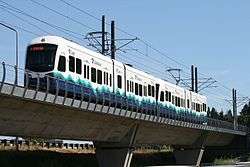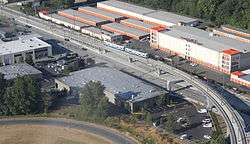Central Link
| Central Link | |
|---|---|
|
| |
|
2-car train on an elevated guideway in Tukwila | |
| Overview | |
| Type | Light rail |
| System | Link light rail |
| Termini |
University of Washington Angle Lake |
| Stations | 16 |
| Daily ridership | 69,125 (August 2016, weekdays)[1] |
| Website | Sound Transit |
| Operation | |
| Opened | July 18, 2009[2] |
| Owner | Sound Transit |
| Operator(s) | King County Metro |
| Character | Underground, at grade, elevated |
| Technical | |
| Line length | 20.35 mi (32.8 km) |
| Number of tracks | 2 |
| Track gauge | 4 ft 8 1⁄2 in (1,435 mm) |
| Electrification |
1,500 Volts DC,[3][4][5] overhead catenary |
Central Link is a light rail line running between the cities of Seattle and SeaTac. It is one of the lines in Sound Transit's Link Light Rail system. Service operates seven days a week, from 5 am to 1 am Monday through Saturday and from 6 am to midnight on Sundays. Trains are composed of two or more cars,[6] each with a capacity of 200 passengers—74 seated and 126 standing.[7] Opened on July 18, 2009, Central Link initially operated between downtown Seattle and Tukwila,[2] on a 13.9-mile (22.4 km) route. Service was extended by 1.7 miles (2.7 km) from Tukwila to SeaTac/Airport on December 19, 2009,[8] by 3.15 miles (5.07 km) from Westlake to the University of Washington on March 19, 2016,[9] and by 1.6 miles (2.6 km) from SeaTac/Airport to Angle Lake on September 24, 2016[10] for a system total of 20.35 miles (32.75 km).[11]
Routing

| Central Link | |||||||||||||||||||||||||||||||||||||||||||||||||||||||||||||||||||||||||||||||||||||||||||||||||||||||||||||||||||||||||||||||||||||||||||||||||||||||||||||||||||||||||||||||||||||||||||||||||||||||||||||||||||||
|---|---|---|---|---|---|---|---|---|---|---|---|---|---|---|---|---|---|---|---|---|---|---|---|---|---|---|---|---|---|---|---|---|---|---|---|---|---|---|---|---|---|---|---|---|---|---|---|---|---|---|---|---|---|---|---|---|---|---|---|---|---|---|---|---|---|---|---|---|---|---|---|---|---|---|---|---|---|---|---|---|---|---|---|---|---|---|---|---|---|---|---|---|---|---|---|---|---|---|---|---|---|---|---|---|---|---|---|---|---|---|---|---|---|---|---|---|---|---|---|---|---|---|---|---|---|---|---|---|---|---|---|---|---|---|---|---|---|---|---|---|---|---|---|---|---|---|---|---|---|---|---|---|---|---|---|---|---|---|---|---|---|---|---|---|---|---|---|---|---|---|---|---|---|---|---|---|---|---|---|---|---|---|---|---|---|---|---|---|---|---|---|---|---|---|---|---|---|---|---|---|---|---|---|---|---|---|---|---|---|---|---|---|---|
Legend | |||||||||||||||||||||||||||||||||||||||||||||||||||||||||||||||||||||||||||||||||||||||||||||||||||||||||||||||||||||||||||||||||||||||||||||||||||||||||||||||||||||||||||||||||||||||||||||||||||||||||||||||||||||
| |||||||||||||||||||||||||||||||||||||||||||||||||||||||||||||||||||||||||||||||||||||||||||||||||||||||||||||||||||||||||||||||||||||||||||||||||||||||||||||||||||||||||||||||||||||||||||||||||||||||||||||||||||||
The northern terminus is at the University of Washington, next to Husky Stadium, where construction on a northern extension is in progress. From there, it travels through a tunnel to Capitol Hill Station on Broadway. The tunnel then transitions into the Downtown Seattle Transit Tunnel at Westlake Station.
Westlake Station is near the intersection of Pine Street and 4th Avenue. Central Link trains operate inside the Downtown Seattle Transit Tunnel, sharing the right-of-way with diesel-electric hybrid buses. The route serves four of the tunnel's five stations (Convention Place Station being the exception). After exiting the southern end of the tunnel at International District/Chinatown Station, the route joins the SoDo Busway (formerly 5th Avenue S.) as a traffic-separated surface route, where it has priority for all intersections. The route serves two stations on the busway and then rises to an elevated section through the SoDo neighborhood.
The route then enters the Beacon Hill Tunnel under Beacon Hill and makes one stop at the underground Beacon Hill Station. Exiting the tunnel, the route becomes grade-separated on an elevated bridge. It serves Mount Baker Station near Franklin High School before it becomes an at-grade surface route on Martin Luther King Jr. Way S. and serves three stations in the Rainier Valley.
Continuing south on Martin Luther King Jr. Way S., it again becomes grade-separated on an elevated guideway and runs alongside Boeing Access Road, E. Marginal Way S., Interurban Avenue S., SR 599, and I-5. Just north of SR 518, the route turns west and parallels SR 518. It stops at Tukwila International Boulevard Station before crossing International Boulevard and running in the center of the North Airport Expressway all the way to the southern terminus of SeaTac/Airport Station, an elevated station lying northeast of the parking garage, immediately west of International Boulevard. An extension south of the airport to Angle Lake opened on September 24, 2016.[12]
|
Stations
| Station Name | Opening Year | City/Neighborhood | Location | Platforms | Notes | |
|---|---|---|---|---|---|---|
| End of line; future extension (Northgate Link Extension) | ||||||
| University Link Tunnel | ||||||
 |
University of Washington | 2016 | University District, Seattle | under Montlake Blvd NE & NE Pacific St | Island | |
 |
Capitol Hill | 2016 | Capitol Hill, Seattle | under Broadway & E John St | Island | Connection to First Hill Streetcar. |
| Downtown Seattle Transit Tunnel | ||||||
.jpg) |
Westlake | 1990 | Downtown Seattle | under Pine Street, between 3rd, 4th and 5th Avenues | Side | Connection to Seattle Center Monorail and South Lake Union Streetcar. |
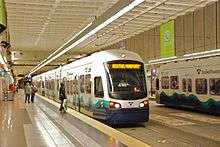 |
University Street | 1990 | Downtown Seattle | under 3rd Avenue, between University and Seneca Streets | Side | |
 |
Pioneer Square | 1990 | Pioneer Square, Seattle | under 3rd Avenue & James Street | Side | Connection to Colman Dock (Washington State Ferries) and King County Water Taxi. |
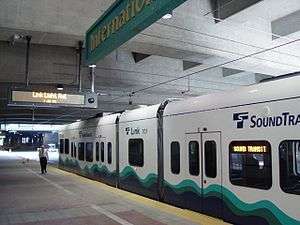 |
International District/Chinatown | 1990 | International District / Chinatown, Seattle | under Union Station at 5th Avenue S & S Jackson Street | Side | Connection to First Hill Streetcar and King Street Station (Amtrak & Sounder). |
| Connection to future extension (East Link Extension) | ||||||
| Surface | ||||||
 |
Stadium | 2009 | SoDo, Seattle | SoDo Busway & S Royal Brougham Way |
Island | Connection to Greyhound.
Larger platform to accommodate large crowds attending events at Safeco Field and CenturyLink Field. |
 |
SODO | 2009 | SoDo, Seattle | SoDo Busway & S Lander Street | Side | |
| Beacon Hill Tunnel | ||||||
| |
Beacon Hill | 2009 | Beacon Hill, Seattle | under Beacon Avenue S & S Lander Street | Island | |
| Elevated | ||||||
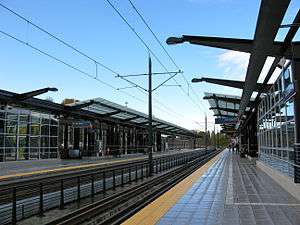 |
Mount Baker | 2009 | Mount Baker, Seattle | Martin Luther King Jr. Way S & Rainier Avenue S | Side | |
| Surface (Martin Luther King Jr. Way) | ||||||
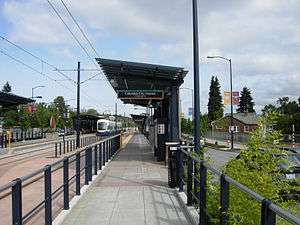 |
Columbia City | 2009 | Columbia City, Seattle | MLK Jr. Way S between S Edmunds & S Alaska Streets |
Side | |
 |
Othello | 2009 | New Holly, Seattle | MLK Jr. Way S between S Othello & S Myrtle Streets |
Side | |
.jpg) |
Rainier Beach | 2009 | Rainier Valley, Seattle | MLK Jr. Way S & S Henderson Street | Island | |
| Elevated | ||||||
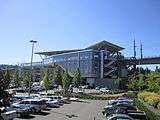 |
Tukwila International Blvd | 2009 | Tukwila | SR 518 & Tukwila International Blvd | Side | 600-space park & ride lot |
 |
SeaTac/Airport | 2009 | SeaTac | East of airport parking garage | Island | Pedestrian bridges to main terminal and kiss-and-ride center at International Blvd |
| Angle Lake | 2016 | SeaTac | S 200th St & 28th Ave S | Island | 1,120 park & ride spaces (1,050 parking garage, 70 surface lot) | |
| End of line; future extension (Federal Way Link Extension) | ||||||
Fares
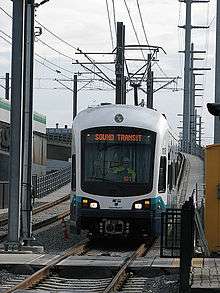
Central Link operates using a proof-of-payment fare system. Passengers are required to purchase a paper ticket or tap their ORCA (and receiving a valid permit to travel) before boarding trains. Sound Transit fare inspectors or police officers randomly board trains and check for valid proof-of-payment. Passengers who are caught traveling without valid proof-of-payment can be fined $124.
The fares for Link are distance-based: $2.25 base fare plus 5 cents per mile, rounded to the nearest 25 cents.[13] The maximum cost of a one-way ticket is $3.25, for a trip between the University of Washington and Sea-Tac Airport.
Passengers who pay using ORCA must tap their cards before boarding and after alighting trains. Passengers using ORCA are charged the maximum fare from the station they are traveling from and are issued a permit to travel when they tap before boarding and, if necessary, receive a refund when they tap after boarding.
Adult fares for Central Link are as follows:[13][14]
| University of Washington | |||||||||||||||
|---|---|---|---|---|---|---|---|---|---|---|---|---|---|---|---|
| $2.25 | Capitol Hill | ||||||||||||||
| $2.50 | $2.25 | Westlake | |||||||||||||
| $2.50 | $2.25 | $2.25 | University Street | ||||||||||||
| $2.50 | $2.25 | $2.25 | $2.25 | Pioneer Square | |||||||||||
| $2.50 | $2.25 | $2.25 | $2.25 | $2.25 | International District/Chinatown | ||||||||||
| $2.50 | $2.25 | $2.25 | $2.25 | $2.25 | $2.25 | Stadium | |||||||||
| $2.50 | $2.25 | $2.25 | $2.25 | $2.25 | $2.25 | $2.25 | SODO | ||||||||
| $2.50 | $2.50 | $2.25 | $2.25 | $2.25 | $2.25 | $2.25 | $2.25 | Beacon Hill | |||||||
| $2.50 | $2.50 | $2.50 | $2.50 | $2.50 | $2.50 | $2.25 | $2.25 | $2.25 | Mount Baker | ||||||
| $2.75 | $2.50 | $2.50 | $2.50 | $2.50 | $2.50 | $2.25 | $2.25 | $2.25 | $2.25 | Columbia City | |||||
| $2.75 | $2.50 | $2.50 | $2.50 | $2.50 | $2.50 | $2.50 | $2.50 | $2.50 | $2.25 | $2.25 | Othello | ||||
| $2.75 | $2.75 | $2.50 | $2.50 | $2.50 | $2.50 | $2.50 | $2.50 | $2.50 | $2.50 | $2.25 | $2.25 | Rainier Beach | |||
| $3.00 | $3.00 | $3.00 | $3.00 | $3.00 | $3.00 | $2.75 | $2.75 | $2.75 | $2.75 | $2.50 | $2.50 | $2.50 | Tukwila International Blvd | ||
| $3.25 | $3.00 | $3.00 | $3.00 | $3.00 | $3.00 | $3.00 | $2.75 | $2.75 | $2.75 | $2.75 | $2.75 | $2.50 | $2.25 | SeaTac/Airport | |
| $3.25 | $3.00 | $3.00 | $3.00 | $3.00 | $3.00 | $3.00 | $3.00 | $3.00 | $3.00 | $2.75 | $2.75 | $2.75 | $2.50 | $2.25 | Angle Lake |
Sound Transit also offers discounted flat rate fares for qualifying Central Link passengers as follows:
| Discount type | Fare |
|---|---|
| Senior (65+) / Disabled / Medicare (Regional Reduced Fare Permit required) |
$1.00 |
| Low-income (ORCA LIFT card required) |
$1.50 |
| Youth (6–18 years) |
$1.50 |
| Children (0–5 years, with fare paying passenger) |
Free |
Transfers
Paper transfers are not accepted or issued on Sound Transit routes. Passengers who use ORCA may transfer between Sound Transit routes or routes operated by most other Puget Sound transit agencies within two hours of initial payment. If the fare for the second route is higher, the difference will be charged.
Headways
Central Link operates on the following schedule:[15]
| Northbound | Southbound | |||
|---|---|---|---|---|
| Time | Headway | Time | Headway | |
| Weekdays | 5:00 am – 5:48 am | 12 | 4:45 am – 6:27 am | 12 |
| 5:48 am – 8:30 am | 6 | 6:27 am – 9:21 am | 6 | |
| 9:30 am – 2:50 pm | 10 | 9:21 am – 2:51 pm | 10 | |
| 2:50 pm – 6:30 pm | 6 | 2:51 pm – 7:21 pm | 6 | |
| 6:30 pm – 10:00 pm | 10 | 7:21 pm – 10:21 pm | 10 | |
| 10:00 pm – 1:00 am | 15 | 10:21 pm – 12:36 am | 15 | |
| Saturday | 5:00 am – 8:00 am | 12 | 4:45 am – 7:51 am | 15 |
| 8:00 am – 10:00 pm | 10 | 7:51 am – 10:21 pm | 10 | |
| 10:00 pm – 12:45 am | 15 | 10:21 pm – 12:36 am | 15 | |
| Sunday | 6:00 am – 8:00 am | 12 | 5:45 am – 7:51 am | 15 |
| 8:00 am – 10:00 pm | 10 | 7:51 am – 10:21 pm | 10 | |
| 10:00 pm – 11:45 pm | 15 | 10:21 pm – 11:36 pm | 15 | |
Travel times
The vehicles operate with an end-to-end travel time of 48 minutes between the University of Washington and Angle Lake.[15] Travel times are as follows;[15] all times measured in minutes.
| University of Washington | |||||||||||||||
|---|---|---|---|---|---|---|---|---|---|---|---|---|---|---|---|
| 4 | Capitol Hill | ||||||||||||||
| 6 | 2 | Westlake | |||||||||||||
| 8 | 4 | 2 | University Street | ||||||||||||
| 11 | 7 | 5 | 3 | Pioneer Square | |||||||||||
| 13 | 9 | 7 | 5 | 2 | International District/Chinatown | ||||||||||
| 15 | 11 | 9 | 7 | 4 | 2 | Stadium | |||||||||
| 17 | 13 | 11 | 9 | 6 | 4 | 2 | SODO | ||||||||
| 20 | 16 | 14 | 12 | 9 | 7 | 5 | 3 | Beacon Hill | |||||||
| 22 | 18 | 16 | 14 | 11 | 9 | 7 | 5 | 2 | Mount Baker | ||||||
| 25 | 21 | 19 | 17 | 14 | 12 | 10 | 8 | 5 | 3 | Columbia City | |||||
| 29 | 25 | 23 | 21 | 18 | 16 | 14 | 12 | 9 | 7 | 4 | Othello | ||||
| 32 | 28 | 26 | 24 | 21 | 19 | 17 | 15 | 12 | 10 | 7 | 3 | Rainier Beach | |||
| 41 | 37 | 35 | 33 | 30 | 28 | 26 | 24 | 21 | 19 | 16 | 12 | 9 | Tukwila International Blvd | ||
| 44 | 40 | 38 | 36 | 33 | 31 | 29 | 27 | 24 | 22 | 19 | 15 | 12 | 3 | SeaTac/Airport | |
| 48 | 44 | 42 | 40 | 37 | 35 | 33 | 31 | 28 | 26 | 23 | 19 | 16 | 7 | 4 | Angle Lake |
There is an 8-minute brisk walk from the SeaTac Airport station to the Alaska Airlines check in at the north end of the airport.[16]
The 38-minute travel time from Westlake Station to SeaTac/Airport Station was similar to the 32-minute scheduled travel time of the now cancelled King County Metro Route 194 bus from Convention Place Station to the airport.[17] Wait times are shorter and access is better, as light rail runs more frequently and during more hours of the day than Route 194 did, and serves more stops between downtown and the airport. Since light rail operates on its own right of way, it is not subject to delays due to traffic congestion.[7] King County Metro discontinued route 194 on February 6, 2010.[18] Riders who boarded Route 194 at the Kent/Des Moines or Star Lake (272nd) freeway stations and are destined north of the airport now have to board ST Route 574 and transfer to light rail at SeaTac/Airport Station. Expanded service on Sound Transit routes 577 and 578 now provide a direct connection between the Federal Way Transit Center and Downtown Seattle. Unlike the former route 194, routes 577 and 578 do not serve the Federal Way Park & Ride,[19] but shorten the trip between Downtown and Federal Way by 26 minutes.[17][19]
Ridership
| Annual Passenger Ridership | ||
|---|---|---|
| Year | Passengers | %± |
| 2009 | 2,501,211 | — |
| 2010 | 6,989,504 | +176.5% |
| 2011 | 7,812,433 | +11.8% |
| 2012 | 8,699,821 | +11.4% |
| 2013 | 9,681,432 | +11.3% |
| 2014 | 10,950,276 | +13.1% |
| 2015 | 11,707,604 | +6.9% |
| Source:[20] | ||
Ridership has significantly risen since the line opened in July 2009, when it averaged 12,000 riders per weekday.[21] After the opening of SeaTac/Airport station in December, ridership rose to 16,979 daily boardings.[22] The growth in ridership was attributed partially to the closure of King County Metro route 194 in February 2010, and shifting of bus routes to feed into the light rail.[23]
By the line's first anniversary in July 2010, Link was averaging 23,400 riders per weekday.[24] By 2011, the line was not meeting the ridership goal of 26,600 per day set prior to the opening, with daily boardings dropping to 21,611.[25] By the following year, however, ridership began to grow past that ridership goal to 28,549 weekday boardings in September 2012.[26] In June 2013, average weekday ridership passed 30,000, increasing 16 percent over the previous June to 31,953.[27][28] Total ridership in 2014 surpassed 10.9 million boardings, a 13 percent increase from 2013, and averaged 32,924 on weekdays.[29]
By the summer of 2015, ridership had reached a daily average of 35,989 for weekday traffic;[30] with the opening of the extension to the University of Washington station in March 19, 2016, weekday ridership has jumped to 65,409 in May 2016.[20][31] A single-day ridership record of 82,361 estimated boardings was set on April 8, 2016,[32] driven by a Seattle Mariners home opener and the Emerald City Comicon.[33] The record itself was surpassed five months later on September 30, estimated at 101,000 riders, fueled by a Washington Huskies football game and Mariners game on a weekday.[34]
Sound Transit measures ridership by using the infrared sensors built into the doorways.[21]
Equipment
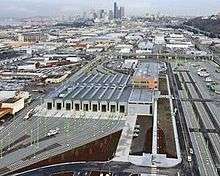
Kinkisharyo-Mitsui was chosen to design and manufacture low-floor light rail vehicles (LRVs) and provide additional equipment and support. Thirty-five light rail cars were delivered between November 2006 and September 2008. Each vehicle is 95 ft (29.0 m) long, 8.7 ft (2.7 m) wide, using two 41 ft (12.5 m) segments and a 8.6 ft (2.6 m) middle cab. Each car can accommodate 200 people each (74 seated), and double-ended to allow travel in either direction. An additional 27 vehicles were delivered to Sound Transit by Kinkisharyo at a rate of one a month, beginning in August 2010.[35]
Initially, two-car trains were operated but were supplemented with three-car trains at rush hours and on weekends with the opening of University Link in 2016.[36] All Central Link stations are built with platforms to handle four-car trains.[37] The maximum speed of the light rail vehicle is 55 mph (89 km/h).[38]
Sound Transit signed a contract with Siemens Mobility in September 2016 to order 122 Siemens S70 light rail vehicles, to be delivered beginning in 2019 for the Northgate, Lynnwood and East extensions. The new vehicles, the largest order in the agency's history, would triple the fleet's size to 184 and will cost approximately $554 million.[39][40]
The overhead catenary that supplies electricity to the LRVs is fed (from substations) at 1,500 Volts DC,[3] a departure from the normal voltage for U.S. light rail systems, 750 V,[4] with Central Link being the first light rail system in North America to use 1,500 V.[5] Sound Transit's other light rail line, the 2003-opened Tacoma Link, uses 750 V.
See also
References
- ↑ "August 2016 Service Performance Report" (PDF). Sound Transit. October 6, 2016. Retrieved October 12, 2016.
- 1 2 "Link light rail launches new era of mobility for central Puget Sound" (Press release). Sound Transit. July 18, 2009. Retrieved August 25, 2016.
- 1 2 "Adopted 2009 Budget" (PDF). Sound Transit. December 2008. p. 53. Archived from the original (PDF) on May 25, 2013. Retrieved August 25, 2016.
- 1 2 Taplin, Michael (October 2009). "Miraculous in Seattle" (feature article on Central Link at the time of its opening). Tramways & Urban Transit magazine, pp. 380–381. UK: LRTA Publishing. ISSN 1460-8324.
- 1 2 Middleton, William D. (April 2006). "Sound Transit Builds for LRT". Railway Age: 43–45. Retrieved November 28, 2012.
- ↑ "Draft 2009 Service Implementation Plan" (PDF). Sound Transit. Archived from the original (PDF) on May 25, 2013. Retrieved August 25, 2016.
- 1 2 "Link Light Rail Train Specifications". Sound Transit. Archived from the original on March 5, 2009. Retrieved August 25, 2016.
- ↑ Lindblom, Mike (December 19, 2009). "Early holiday arrival: light rail to airport". The Seattle Times. Retrieved December 19, 2009.
- ↑ Daniels, Chris; Green, Josh; Courtney, Ricky (March 19, 2016). "University Link light rail opens". KING-TV. Retrieved March 20, 2016.
- ↑ Lindblom, Mike (September 22, 2016). "Angle Lake light-rail station opens Saturday with party". The Seattle Times. Retrieved September 25, 2016.
- ↑ "Schedules". Sound Transit. Retrieved March 29, 2016.
- ↑ "New Angle Lake light-rail station to open Sept. 24". September 25, 2016. Retrieved October 10, 2016.
- 1 2 "SoundTransit - Link light rail fares - Adult Fares". Sound Transit. Retrieved August 25, 2016.
- ↑ "Board adopts fares for Link light rail; adult trips will range from $1.75 to $2.50" (Press release). Sound Transit. March 26, 2009. Retrieved May 19, 2009.
- 1 2 3 "Link light rail - Link weekday schedule". Sound Transit. Retrieved November 22, 2016.
- ↑ "Traveler tip: Taking light rail to Sea-Tac airport". The Seattle Times. June 3, 2016. Retrieved June 18, 2016.
- 1 2 "Metro Route 194". King County Metro. Archived from the original on December 16, 2008. Retrieved January 14, 2009.
- ↑ "Metro Schedule and Route Revisions September 2009 & February 2010". King County Metro. Retrieved June 9, 2009.
- 1 2 "Sound Transit: 577 Seattle - Federal Way / 578 Seattle - Puyallup Weekday Bus Schedule". September 19, 2009. Archived from the original on October 22, 2009. Retrieved January 26, 2010.
- 1 2 "Quarterly Ridership Report". Sound Transit. Retrieved August 25, 2016.
- 1 2 Lindblom, Mike (July 30, 2009). "Light rail averaging 12,000 riders per weekday so far". The Seattle Times. Retrieved August 25, 2016.
- ↑ "First Quarter 2010 Service Delivery Quarterly Performance Report" (PDF). Sound Transit. Retrieved August 25, 2016.
- ↑ Gilmore, Susan (February 1, 2010). "Metro route changes start Saturday". The Seattle Times. Retrieved August 25, 2016.
- ↑ "Link light rail celebrates one year anniversary" (Press release). Sound Transit. July 16, 2010. Retrieved August 25, 2016.
- ↑ Lindblom, Mike (March 3, 2011). "Sound Transit ridership falls short of its goals". The Seattle Times. Retrieved August 25, 2016.
- ↑ "Record ridership on Sound Transit trains and buses" (Press release). Sound Transit. November 2, 2012. Retrieved August 25, 2016.
- ↑ "Sound Transit Ridership Summary, June 2013" (PDF). Sound Transit. August 22, 2013. Retrieved August 25, 2016.
- ↑ "Link light rail celebrates fourth anniversary amid big crowds" (Press release). Sound Transit. July 11, 2013. Retrieved July 19, 2013.
- ↑ "Sound Transit's trains and buses reach record ridership levels in 2014" (Press release). Sound Transit. February 26, 2015. Retrieved August 25, 2016.
- ↑ "Sound Transit trains, buses set more ridership records" (Press release). Sound Transit. August 27, 2015. Retrieved August 25, 2016.
- ↑ "Link light rail turns seven today amid record-breaking ridership surge" (Press release). Sound Transit. July 18, 2016. Retrieved August 25, 2016.
- ↑ "New light rail riders drive record-breaking second quarter ridership" (Press release). Sound Transit. August 25, 2016. Retrieved August 25, 2016.
- ↑ "University Link ridership sprints out of the starting gates". Sound Transit. April 20, 2016. Retrieved August 25, 2016.
- ↑ Lindblom, Mike (October 6, 2016). "UW-Stanford game helps break light-rail record of more than 100,000 riders". The Seattle Times. Retrieved October 6, 2016.
- ↑ "Sound Transit (ST), Seattle, Washington" (PDF). Kinkisharyo. Archived from the original (PDF) on March 31, 2016. Retrieved August 16, 2016.
- ↑ Lindblom, Mike (August 8, 2016). "Sound Transit keeping close eye on crowded light-rail trains". The Seattle Times. Retrieved August 9, 2016.
- ↑ "Four new light rail cars proposed for Sound Transit's Airport Link extension" (Press release). Sound Transit. October 20, 2005. Retrieved August 9, 2016.
- ↑ "The Light-Rail Train" (PDF). The Seattle Times. July 2009. Retrieved August 16, 2016.
- ↑ "122 Siemens S70 LRVs for Sound Transit". Railway Age. September 29, 2016. Retrieved September 29, 2016.
- ↑ Demay, Daniel (September 22, 2016). "Sound Transit places $554M order for more light rail cars". Seattle Post-Intelligencer. Retrieved September 29, 2016.
External links
| Wikimedia Commons has media related to Central Link. |
- Sound Transit Maps
- Central Link ride along video at The Seattle Times.
- Official Sound Transit website
- Puget Sound Transportation Projects: Seattle Link
- Photos of Sound Transit Flickr group, includes photos of Central Link.
- Kinkisharyo Technical specs for Link Light Rail Vehicles
